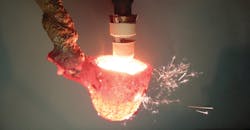CGI Output Hit by Market Malaise
SinterCast AB pointed to weak demand for industrial freight services and heightened uncertainty in global markets as the source of a marked drop in compacted-graphite iron (CGI) production during the third quarter of 2025. This meant series production fell to 135,000 metric tons (or 2.7 million “engine equivalents”, each unit equal to 50 kg) of CGI.
The latest figure followed rising CGI series production in the second quarter of this year.
Stockholm-based SinterCast’s CGI process control technology is used by foundries worldwide for series production of engine castings.
The latest figure indicates a -17% drop in production compared to the first half of 2025 (3.25 million engine equivalents) and a -23% reduction compared to 3Q 2024 (3.5 million engine equivalents.)
According to the developer, the year-over-year decrease was due to a -33% drop in commercial vehicle production, extended summer shutdowns by most SinterCast customers, and the end of a high-volume program in September 2024 that represented a loss of 400,000 engine equivalents.
“It is clearly a challenging time for the automotive industry. Many OEMs – and their Tier 1 foundry suppliers – showed resilience during the second quarter. However, as the uncertainty persisted, most of our commercial vehicle and foundry customers reduced production schedules and inventories in the third quarter,” commented Dr. Steve Dawson, president and CEO of SinterCast.
Compacted graphite iron (CGI) is a lightweight material that offers greater tensile strength, stiffness, and fatigue strength than gray iron or aluminum. As such it has gained acceptance for casting diesel engines, destined for commercial vehicles and industrial systems.
But SinterCast also reported that CGI production focused on passenger vehicle and off-road sectors remained strong during the third quarter, up +11% year-over-year.
“While the short-term conditions are difficult, we remain well-positioned for growth,” Dawson continued. “Our order book is strong, with increased global uptake of CGI and defined new programs providing growth to the 5 and 6 million engine-equivalents milestones.
“The longer-term outlook also continues to improve with new and pending legislation favoring internal combustion engines with clean, net-zero fuels both in Europe and the U.S.,” he added.
